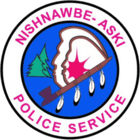Nishnawbe-Aski Police Service facts for kids
Quick facts for kids Nishnawbe-Aski Police Service |
|
|---|---|
 |
|
| Agency overview | |
| Formed | 1994 |
| Operational structure | |
| Headquarters | 973 Balmoral St Thunder Bay, Ontario |
| Officers | 203 |
| Civilians | 30 |
| Elected officer responsible |
|
| Agency executive |
|
| Facilities | |
| Divisions | 34 |
The Nishnawbe-Aski Police Service (NAPS) is the police force for the Nishnawbe-Aski Nation (NAN) in Ontario, Canada. It was created to provide policing that respects the culture and needs of the local Indigenous communities.
NAPS is a very large police force. It is the biggest Indigenous police force in Canada and the second-biggest in North America. Its officers are responsible for an area in northern Ontario that is about the same size as the country of France. This huge area is part of the land covered by historic agreements called Treaty 9 and Treaty 5.
The police service has 34 local offices, called detachments, in different NAN communities. About 60% of its 203 police officers are Indigenous. The funding for NAPS comes from both the government of Canada (52%) and the government of Ontario (48%).
Contents
History of NAPS
The Nishnawbe-Aski Police Service was officially formed on January 14, 1994. It was created through a special partnership between the Canadian government, the Ontario government, and the Nishnawbe-Aski Nation. The main goal was to create a police service that was run by and for Indigenous people.
The creation of NAPS happened in two main steps.
- Phase One (1994): Starting on April 1, 1994, all First Nation police officer jobs were moved from the Ontario Provincial Police (OPP) to the new NAPS.
- Phase Two (1998): On January 1, 1998, NAPS took over policing for eight more First Nation communities.
By April 1, 1999, NAPS had taken full responsibility for policing in the region from the OPP. This was a major step in self-governance for the Nishnawbe-Aski Nation.
Challenges and Improvements
NAPS has faced many challenges, especially with its buildings and funding. For a long time, many of its police stations were old and did not meet safety standards. Officers sometimes had to live in crowded housing.
Unsafe Buildings
In 2008, the conditions were so bad that only one of the 35 police stations met the national building code. Some stations did not have basic needs like running water. For example, the station in Kasabonika First Nation had to be closed for a while because it was unsafe. A serious fire at the Kashechewan station in 2006 highlighted how dangerous these conditions were.
These problems were brought to the attention of the government. In 2009, a new agreement was made to help fix the issues.
Funding Issues
NAPS has also struggled with not having enough money to cover all its costs. In 2020, its budget was about $37.7 million, but its expenses were almost $40 million.
However, things have been improving. In 2018, a new funding agreement was signed. This deal provided money to hire 79 new officers over five years. It also included funds to upgrade important buildings and communication systems.
A Sacred Calling Documentary
A Sacred Calling is an 18-minute documentary film. It was made by RoseAnne Archibald, a former National Chief of the Assembly of First Nations. The film shows the difficult conditions NAPS officers work in.
The documentary was created to show the federal and provincial governments why NAPS needs more support and funding. It shows officers living in motels and using simple tools to keep their stations running. The film helps people understand the daily challenges of policing in remote northern communities.
NAPS Locations and Structure
NAPS has its main headquarters in Thunder Bay, Ontario. It also has three regional offices in Cochrane, Sioux Lookout, and Thunder Bay. These offices manage the 34 police detachments spread across the vast Nishnawbe-Aski Nation territory.
The police service is led by a Chief of Police. It is overseen by a board made up of representatives from each NAN Tribal Council. This ensures that the police service is accountable to the communities it serves.
Police Vehicles
To travel across the large and often rugged territory, NAPS officers use a variety of vehicles.
- Trucks and SUVs: Ford F-Series pickups and Chevrolet Tahoe SUVs are used for patrols, especially in areas with rough roads.
- Cars: Dodge Charger cruisers are used for regular police duties.
- Vans: Ford E-Series vans are used for transporting people or equipment.
- Airplanes: Because many communities are remote and can only be reached by air, NAPS uses a Pilatus PC-12 airplane, operated by Wasaya Airways, to fly officers and supplies.

